Jie Fang “Liberation” 1-4-1 mainline general purpose steam locomotive.
1918 - 1945 Japanese
1952 - 1960 Chinese
Total produced in China 455 (1952-60)
Chairman Mao Tse Tung class train. JF-304 was built in Japan in 1941 and renamed after capture in October 1946. Used at least once by Mao.
The first 20 units were built in the USA in 1918, with another 2000 units built in Japan and China for use in Japanese-occupied northeast China and Korea. After the wars over 400 more units were made in China for domestic use. Some were in service until c. 1995.
Length 22.63 m
Loco weight 103.85 tonnes
Maximum speed 80 km/h
Power output 1,152 kW
Tractive effort 240.3 kN
Their service life on mainline routes ended in 1996, but some continued lives in industrial locations.
 |
| Chairman Mao Tse Tung class train. JF-304 |
 |
| Fearless Leader in the cab of the Mao locomotive |

















































